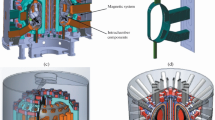Abstract
Recent proposals for ignition tokamaks containing superconductors are reviewed. As the funding prospects for the U. S. fusion program have worsened, the proposed designs have been shrinking to smaller machines with less ambitious goals. The most recent proposal, the Tokamak Fusion Core Experiment (TFCX), was based on internally cooled cabled Nb3Sn conductors for the options which used superconductors. Internally cooled conductors are particularly advantageous in their electrical insulating properties and in the similarity of their winding procedures to those of conventional copper coils. Epoxy impregnation is possible and is advantageous both structurally and electrically. The allowable current density for this type of conductor was shown to be larger than the current density for more conventional superconducting technology. The TFCX effort identified research and development needed in advance of TFCX or any other large ignition machine. These topics include the metal used for the conduit; nuclear effects on materials; properties of electrical and thermal insulators; extension of superconducting technology to the sizes of coils envisioned and to the field level envisioned; pulsed coil superconducting technology; joints and insulating breaks in conductors; heat removal or flow path length limitations; mechanical behavior of potted conductor bundles; instrumentation; and fault modes and various questions integrated with overall machine design.
Access this chapter
Tax calculation will be finalised at checkout
Purchases are for personal use only
Preview
Unable to display preview. Download preview PDF.
Similar content being viewed by others
References
T. Ee Shannon, Engineering considerations in the selection of the tokamak to follow the Tokamak Fusion Test Roactor (TFTR), in: “Proceedings of the 6th ANS Topical Meeting on the Technology of Controlled Nuclear Fusion” (1985).
Tokamak Fusion Core Experiment,” Princeton Plasma Physics Laboratory Report, Princeton, NJ (1984).
P. Ao Materna, Comprehensive Design Procedure and spreadsheet for internally cooled cabled superconductors, IEEE Trans. Mag., Mag-21: 1091 (1985).
H. Becker et al, “Structural Behavior of Internally Cooled Cabled Superconductors Under Transverse Load,” Report No. PFC/RR85-10, Plasma Fusion Center, Massachusetts Institute of Technology Cambridge, MA (1985).
Author information
Authors and Affiliations
Editor information
Editors and Affiliations
Rights and permissions
Copyright information
© 1986 Plenum Press, New York
About this chapter
Cite this chapter
Materna, P.A. (1986). Application of Internally Cooled Superconductors to Tokamak Fusion Reactors. In: Fast, R.W. (eds) Advances in Cryogenic Engineering. Advances in Cryogenic Engineering, vol 31. Springer, Boston, MA. https://doi.org/10.1007/978-1-4613-2213-9_15
Download citation
DOI: https://doi.org/10.1007/978-1-4613-2213-9_15
Publisher Name: Springer, Boston, MA
Print ISBN: 978-1-4612-9299-9
Online ISBN: 978-1-4613-2213-9
eBook Packages: Springer Book Archive




